#source: bandstand the musical
Explore tagged Tumblr posts
Text
Des: I'm trying my best
Jake: I know. Heartbreaking isn't it?
#des courtney#jake doyle#incorrect republic of doyle quotes#source: bandstand the musical#republic of doyle
9 notes
·
View notes
Text
Nick: Gang, get in here. We’re going to New York City!
Julia and Wayne, confused: New York City?
Donny, excited: New York City?!
Nick: New York City!
Davy, shouting from the other room: SHUT THE FUCK UP!
#bandstand#donny novitski#julia trojan#bandstand broadway#davy zlatic#wayne wright#nick radel#bandstand musical#source: helluva boss#you’re telling me that this isn’t how a band in New York city happened?!
20 notes
·
View notes
Text
'You could almost feel the excitement coming up out of the crowds when that kid stood up to sing,' said Dorsey, whom Sinatra made the godfather of his firstborn child. 'Remember, he was no matinée idol. He was just a skinny kid with big ears. I used to stand there so amazed I'd almost forget to take my own solos.' In fact, the secret of Sinatra's vocal impact lay primarily in his observations of Dorsey's trombone playing. 'He would take a musical phrase and play it all the way through seemingly without breathing for eight, ten, maybe sixteen bars. How in the hell did he do that?' Sinatra told his daughter Nancy in her book Frank Sinatra: An American Legend. 'I used to sit behind him on the bandstand and watch, trying to see him sneak a breath. But I never saw the bellows move in his back. His jacket didn't even move. So I edged my chair around to the side a little and peeked around to watch him. Finally, after a while, I discovered that he had a ‘sneak pinhole' in the corner of his mouth—not an actual hole but a tiny place he left open where he was breathing. In the middle of a phrase, while the tone was still being carried through the trombone, he'd go ‘shhh' and take a quick breath and play another four bars.'
Sinatra began to 'play' his voice like Dorsey's trombone. 'I began swimming in public pools, taking laps under water and thinking song lyrics to myself as I swam holding my breath,' Sinatra said. 'Over six months or so, I began to develop and delineate a method of long phraseology. Instead of singing only two bars or four bars at a time—like most of the other guys around—I was able to sing six bars, and in some songs eight bars, without taking a visible or audible breath. That gave the melody a flowing, unbroken quality and that's what made me sound different.' His sound astonished even the professionals. 'After the first eight bars, I knew I was hearing something I'd never heard before,' I was told by Jo Stafford, who had never seen or heard Sinatra before he walked onstage with her and the Pied Pipers for his début with Dorsey.
~John Lahr [source]
0 notes
Text
Davy: if rubbing alcohol fixes the outside boo-boo, drinking alcohol fixes the inside boo-boo
Julia: Dave no
#incorrect bandstand quotes#source: a screenshot of a text conversation seen on facebook#bandstand#bandstand the musical#davy zlatic#julia trojan#is this not a direct quote from the show?#alcohol tw#tw alcohol
133 notes
·
View notes
Quote
when freud said bisexuality is what happens when you dont fully develop a brain he was right and im proof
probably donny
#bandstand#bandstand broadway#bandstand musical#donny novitski#incorrect quotes#source: tumblr#specifically biwlw
56 notes
·
View notes
Text
Davy: I spy with my little eye something beginning with 's'
Johnny: A saxophone?
Davy: No
Jimmy: *looks at Wayne and Nick arguing* Sexual tension?
#source: ????#davy zlatic#jimmy campbell#johnny simpson#donny nova band#donny novitski#julia trojan#wayne wright#nick ridel#brandon j. ellis#james nathan hopkins#joe carroll#joey pero#alex bender#geoff packard#incorrect bandstand quotes#bandstand#bandstand the musical#mine
127 notes
·
View notes
Note
3, 8, 11, 12, 19, 22, 31, 40, 41, 48
These are a lot, and you are not required to answer them all, or answer promptly.
I am simply very curious about your obsession about this piece of media.
You are very normal about it, I promise *lying*
I am so abnormal about newsies. I start hyperventilating whenever I watch it.
3. Quote from newsies
"Either they gives us our rights or we gives them a war!" Just. Chills whenever I hear it.
8. Newsies fanwork that you’ve created
That one newsies lineup drawing I did back in October. I just think it's neat
11. Romantic ‘Ship (OTP)
Javid/Javy. I'm so mentally ill over them (or maybe I just like red and blue dynamics). I don't know why but I am shaking them like a snowglobe
12. Non-romantic relationship between two characters
Medda and Jack. Maybe it's because I have a rough relationship with my mother figures but it just makes me happy to see a mother-son relationship like that
19. Historical or modern AU
I like the modern au for funny purposes. Historical is my favorite though
22. Crutchie/Crutchy
I'm so glad you asked. He is The Silly ever. He definitely trips people with his crutch btw. Especially Kid Blink.
31. 3 background characters of your choice
Romeo. He tries to lift heavy things to impress girls but he always fumbles and ends up just making the girls laugh instead
Specs. He's really spaced out all the time and loses focus really easily. Because of this, Race started a rumor that he's an opium addict (it's not true, though. Specs is just. Like that)
Kid Blink. He HATES it when people call him a pirate
40. Why do you like newsies?
It's a story about the oppressed rising up to demand their rights. It's also a major source of gender envy. Also the music is good!! And it's a flop movie from the 90s. What's not to love?
41. How did you first discover newsies?
We watched 92sies when I was just a freshman in drama class and I thought it was just ok. Then I rediscovered it when I was older and fell in love with it for the first time
48. What other things (books, musicals, etc) would you recommend newsies fans check out?
Bandstand, Hadestown, and West Side Story are all pretty good musicals if you like Newsies. They're all pretty popular but I couldn't think of anything else
8 notes
·
View notes
Text
There's a musical about the Hello Girls!?!??! Oh my god this is amazing! Is there anywhere that I can watch it?? Does anyone have a boot or a recording or anything? Cause I need to see this show immediately. The Hello Girls in WW1 are a huge interest of mine. And this show looks so good.
I am slightly confused as to why they seem more like a jazz band when the Hello Girls were female switchboard operators attached to the army during WW1. But here is some more information about the show. It sounds amazing and I appreciate how historically accurate it looks. Grace Banker was the real Chief Operstor of the Hello Girls so I love that shes the protagonist for this musical. And like Bandstand, all the actors are also musicians!
"The protagonist of that tale is Grace Banker (a commanding Ellie Fishman), chief of the first female telephone operators unit of the US Army Signal Corps. The unit was set up in 1917 on the orders of General Pershing (Scott Wakefield), who wanted skilled telephone operators to ensure effective communication between the American Expeditionary Forces in Europe. Of course, the best operators at that time were women, so that's who Pershing set out to recruit.
In order to coordinate with Ferdinand Foch's army, the operators also need to be fluent in French, making Franco-American Louise LeBreton (the feisty Cathryn Wake) a shoo-in. Idaho farm girl Helen Hill (Chanel Karimkhani) has been speaking French with her maman since she could crawl. Bertha Hunt (Lili Thomas) isn't content to sit at home while her husband ships off, so she joins the army too. Suzanne Prevot (Skyler Volpe) sees enlistment as an opportunity for adventure. She convinces Grace to join her, arguing, "Girls like us – we aren't cut out for tending Victory Gardens." Of course, Grace will have to cultivate her professional relationship with her immediate superior, Lt. Joseph Riser (Arlo Hill), a man's man who is none too thrilled about leading a company of ladies.
Mills (who wrote the music and lyrics) has filled this action-packed war story with instant-classic songs, like the wickedly fun "Je m'en Fiche," about a night of revelry before shipping out that features the saucy lyric, "Cause once the epaulettes are off, / I'm sorry, but all bets are off." Grace gets a jaw-dropping second act number with "Twenty," a song that ends with Fishman doing 20 pushups. "Quinze Minutes" touchingly depicts life between the shells of the Paris Gun in three-four time, and the rousing anthem "Making History" will send you out the door singing."



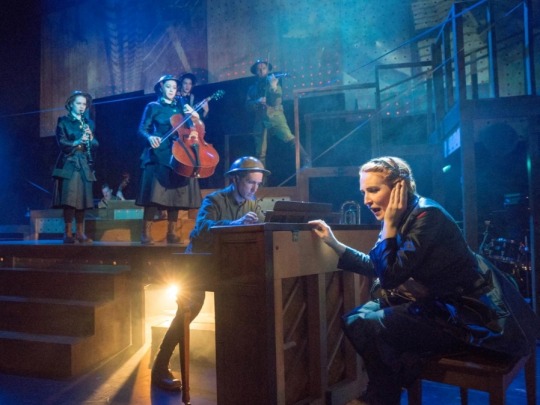

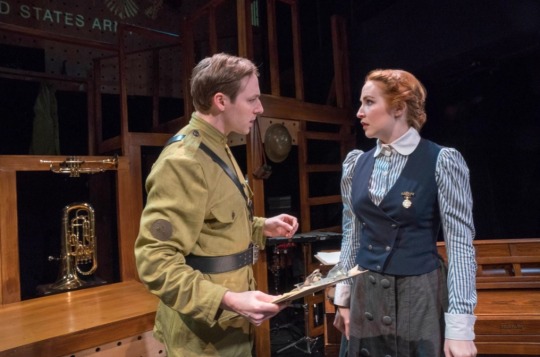

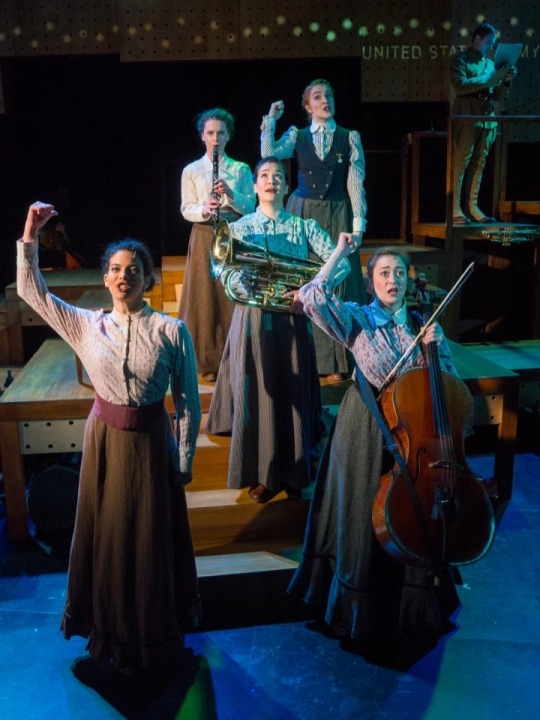
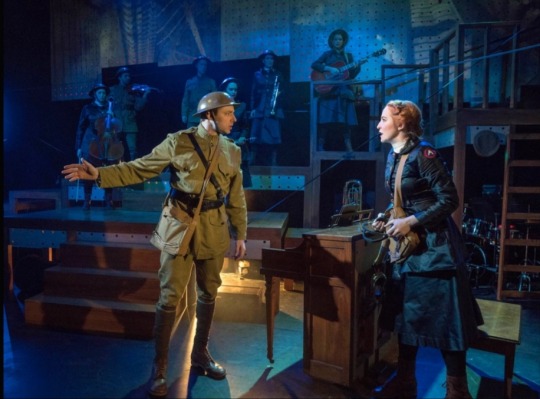
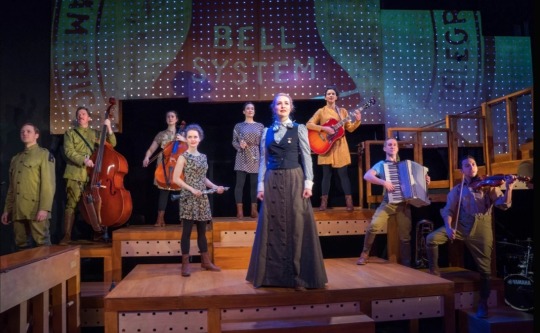
Sources: https://www.playbill.com/article/an-exclusive-look-at-the-hello-girls-musical
https://www.thehellogirlsmusical.com/media
https://www.theatermania.com/off-broadway/reviews/the-hello-girls-new-musical-female-army-world-war-i_87201.html
6 notes
·
View notes
Photo


The Savoy Ballroom was a large ballroom for music and public dancing located at 596 Lenox Avenue, between 140th and 141st Streets in the Harlem neighborhood of Manhattan, New York City. Lenox Avenue was the main thoroughfare through upper Harlem. Poet Langston Hughes calls it the Heartbeat of Harlem in Juke Box Love Song, and he set his work "Lenox Avenue: Midnight" on the legendary street. The Savoy was one of many Harlem hot spots along Lenox, but it was the one to be called the "World's Finest Ballroom". It was in operation from March 12, 1926, to July 10, 1958, and as Barbara Englebrecht writes in her article "Swinging at the Savoy", it was "a building, a geographic place, a ballroom, and the 'soul' of a neighborhood". It was opened and owned by white entrepreneur Jay Faggen and Jewish businessman Moe Gale. It was managed by African-American business man and civic leader Charles Buchanan. Buchanan, who was born in the British West Indies, sought to run a "luxury ballroom to accommodate the many thousands who wished to dance in an atmosphere of tasteful refinement, rather than in the small stuffy halls and the foul smelling, smoke laden cellar nightclubs ..."
The Savoy was modeled after Faggen's downtown venue, Roseland Ballroom. The Roseland was a mostly white swing dance club. With swing's rise to popularity and Harlem becoming a connected black community, The Savoy gave the rising talented and passionate black dancers an equally beautiful venue. The ballroom, which was 10,000 square feet in size, was on the second floor and a block long. It could hold up to 4,000 people. The interior was painted pink and the walls were mirrored. Colored lights danced on the sprung layered wood floor. In 1926, the Savoy contained a spacious lobby framing a huge, cut glass chandelier and marble staircase. Leon James is quoted in Jazz Dance as saying, "My first impression was that I had stepped into another world. I had been to other ballrooms, but this was different – much bigger, more glamour, real class ..."
The Savoy Ballroom was named after the Savoy Hotel in London as those who named the ballroom felt this gave the ballroom a classy, upscale feeling, as the hotel is a very elite, upscale hotel.
The Savoy was popular from the start. A headline from the New York Age March 20, 1926, reads "Savoy Turns 2,000 Away On Opening Night – Crowds Pack Ball Room All Week". The ballroom remained lit every night of the week.
The Savoy had the constant presence of the best Lindy Hoppers, known as "Savoy Lindy Hoppers". Occasionally, groups of dancers such Whitey's Lindy Hoppers turned professional and performed in Broadway and Hollywood productions. Whitey turned out to be a successful agent, and in 1937 the Marx Brothers' movie A Day at the Races featured the group. Herbert White was a bouncer at the Savoy who was made floor manager in the early 1930s. He was sometimes known as Mac, but with his ambition to scout dancers at the ballroom to form his own group, he became widely known as Whitey for the white streak of hair down the center of his head. He looked for dancers who were "young, stylized, and, most of all, they had to have a beat, they had to swing".
Unlike many ballrooms such as the Cotton Club, the Savoy always had a no-discrimination policy. The clientele was 85% black and 15% white, although sometimes there was an even split. Lindy hop dancer Frankie Manning said that patrons were judged on their dancing skills and not on the color of their skin: "One night somebody came over and said, 'Hey man, Clark Gable just walked in the house.' Somebody else said, 'Oh, yeah, can he dance?' All they wanted to know when you came into the Savoy was, do you dance?".
The northeast corner of the dance floor, nicknamed "Cats' Corner," was monopolized by the best and boldest dancers. Some sources claim only Whitey's Lindy Hoppers were permitted to dance there, while others are less specific. Competition for a place in Cats' Corner was fierce, and every serious hopper awaited the nightly "showtime". Other dancers would create a horseshoe around the band and "only the greatest Lindy-hoppers would stay on the floor, to try to eliminate each other". On 140th street was the opposite, mellow corner which was popular with dancing couples. The tango dancer known as The Sheik frequented this corner.
Many dances such as Lindy Hop (which was named after Charles Lindbergh and originated in 1927) were developed and became famous there. It was known downtown as the "Home of Happy Feet" but uptown, in Harlem, as "the Track" because the floor was long and thin. The Lindy Hop is also known as The Jitterbug and was born out of "mounting exhilaration and the 'hot' interaction of music and dance". Other dances that were conceived at the Savoy are The Flying Charleston, Jive, Snakehips, Rhumboogie, and variations of the Shimmy and Mambo. Capitol Records released at least one album devoted to the club, The Home of Happy Feet, from 1959.
It is estimated that the ballroom generated $250,000 in annual profit in its peak years from the late 1920s to the 1940s. Every year the ballroom was visited by almost 700,000 people. The entrance fee was 30 to 85 cents per person, depending on what time a person came. Thirty cents was the base price, but after 6pm the fee was 60 cents, and then 85 cents after 8pm. The Savoy made enough money by its peak in 1936 that $50,000 was spent on remodeling.
The ballroom had a double bandstand that held one large and one medium-sized band running against its east wall. Music was continuous as the alternative band was always in position and ready to pick up the beat when the previous one had completed its set. The bouncers, who had previously worked as boxers, basketball players, and the like, wore tuxedos and made $100 a night. The floor was watched inconspicuously by a security force of four men at a time who were headed by Jack La Rue, and no man was allowed in who wasn't dressed in a jacket with a tie. Besides the security staff, the Savoy was populated by "Harlem's most beautiful women": the Savoy Hostesses. They would be fired for consorting with patrons outside the ballroom, but inside the hostesses would teach people to dance and were dance partners for anyone who purchased a 25 cent dance ticket. Roseland Ballroom hostesses often visited the Savoy on their night off; this inspired Buchanan to create Monday Ladies-Free Nights. Other special events began during the week, including the giveaway of a new car every Saturday. The floor had to be replaced every three years due to frequent use.
During the 1930s, Chick Webb was the bandleader of the Savoy's most popular house band. Ella Fitzgerald, fresh from a talent show victory at the Apollo Theater in 1934, became its teenage vocalist. Webb also recorded the 1934 big band song and jazz standard "Stompin' at the Savoy", which is named for the Savoy. The Savoy was the site of many Battle of the Bands or Cutting Contests, which started when the Benny Goodman Orchestra challenged Webb in 1937. Webb and his band were declared the winners of that contest. In 1938, Webb was challenged by the Count Basie Band. While Webb was declared the winner again, there was a lack of consensus on who won. Earle Warren, alto saxophonist for Basie, reported that they had worked on the song "Swingin' the Blues" for competing and says, "When we unloaded our cannons, that was the end".
Floating World Pictures made a documentary called The Savoy King about the ballroom. It was shown at the 50th New York Film Festival. Other prominent Savoy house bandleaders included Al Cooper, Erskine Hawkins, Lucky Millinder (with Wynonie Harris on vocals), Buddy Johnson, and Cootie Williams.
The Savoy participated in the 1939 New York World's Fair, presenting "The Evolution of Negro Dance".
The ballroom was shut down in April 1943 as a result of "charges of vice filed by the police department and Army". Its license was renewed in mid-October of the same year.
9 notes
·
View notes
Text
Nick: Guys.
Donny and Julia: What?
Nick: What is this? When did you turn into an old married couple?
#bandstand#donny novitski#julia trojan#bandstand broadway#bandstand musical#broadway#nick radel#wayne wright#source: percy jackson and the olympians
18 notes
·
View notes
Note
17 and 18 for the musical asks?
17. biggest "dream" role (a part you'll probably never play because of gender, age, voice part, race, show rights, etc.)
in no particular order (w/reasons)
Julia Trojan (Bandstand) - vocally I could probably do it but she's so far outside of my type that I don't think any director would consider me for the role
Chris Hargensen (Carrie) - same as above, also I'm fat and therefore will never get to play the Mean Girl
Winnie Foster (Tuck Everlasting) - I turn twenty in a few months
Judith Ford (36 Questions) - source material is a podcast and I don't see them ever turning it into a stage musical but I am telling you I would NAIL this one
18. biggest "goal" role (a part you don't intend on ending your theatre career without playing)
would genuinely sell one of my kidneys to play Medium Alison in Fun Home
send me musical theater asks!!
3 notes
·
View notes
Text
Laura Osnes gif pack

Click the source link to be directed to a download for 500 400x225 px gifs of musical theatre actress, Laura Osnes. All of these gifs were created by me from scratch, and you are free to use them however you wish. Please like/reblog if you use/save - thank you!
Project: Various cabaret performances, promotional material from Bonnie and Clyde, Cinderella, and act one of Bandstand, a bootleg of Carousel, and other assorted videos. Age: Mid 20s-30s Ethnicity: Caucasian Hair colors included: Brunette, red Eye color: Blue
NOTE: This is the only the first Laura Osnes pack.
#gifpackshq#gmcentral#laura osnes#laura osnes gifs#laura osnes gif hunt#laura osnes gif pack#gif pack#gif hunt#babys second gif pack!!!#look what i made#request#knowing me and my track record thus far#the next one will probably be in like 3-5 months lol#but since this was a request i figured no harm in getting this one out now#sorry it took so long#i am really bad at this kind of thing lol#but i've been staring at bliss gifs for a pretty long time while i edit them#(when their day comes you will see why they're taking so fking long)#and i needed a break
6 notes
·
View notes
Text
Cecil Taylor Quintet – Lift the Bandstand (Fundacja Luchaj)


Performance as ritual is a natural component of improvised music. Cecil Taylor was one of its most potent and preeminent proponents, particularly in the later years of his career. Lift the Bandstand comes from that period, specifically a concert conducted at the annual Tampere Jazz Happening in Finland in 1988. Steve Lacy was in the audience and inadvertently coined both the title of disc and the performance. The former appellation was in direct response to the assembled ensemble’s prodigious powers of musical levitation. The hour-and-a-quarter collective improvisation they left behind is known as “Desperados,” another aptly colorful assignation. Ritual informs it as precursor, but it’s a welcome and relatively anomalous example in Taylor’s discography of extemporaneousness being the exclusive fuel source.
Taylor was at point of musical restlessness where regular ensemble configurations were comparatively infrequent, but repeated associations with individual players were conversely common. Finnish soprano saxophonist Harri Sjöstrom, American cellist Tristan Honsinger and German drummer Paul Lovens had all first collaborated with the pianist through connections established during Taylor’s epochal Berlin residencies at the close of the 1980s. A colleague and countryman of Sjöstrom’s, bassist Teppo Hauta-aho gained introductions through that commonality. Sjöstrom approached Taylor with the idea of using the resulting quintet as a vehicle for free improvisation and the pianist cottoned quickly to the prospect.
That deviation marks the music from its outset. Absent are any of Taylor’s elaborate preparatory charts or schematics. Missing, too, are the crucibles of his exhaustive and demanding rehearsals. Instead, it’s simply five men taking the stage with the semblance of a clean slate between them. Taylor’s vocalizations and the diffused contributions of his colleagues occupy the opening minutes. Ritual must be invoked and observed. Devoid of visual and spatial context, not much of it translates well, but once Taylor plants himself firmly at the piano stool flanked by scraping strings, the music turns into a turbulent, extended series of cloudbursts. Figurative thunder, lightning and torrential rain all leap to mind in the glorious tempest that follows.
Parsing individual contributions is possible throughout thanks to a radio recording that reliably captures the principals, but the pursuit increasingly feels moot in the face of the larger edifice being erected. Sjöstrom’s straight horn wheedles and skids. Lovens’ sticks clatter and clap. Honsinger hatches a hornet’s nest worth of buzzing and strafing arco activity. Hauta-aho is his racing shadow several register rungs lower. Taylor percolates fiercely at the center, his clipped note clusters spinning off on caroming trajectories. Suddenly, an hour elapsed, the density relents and a more porous collectivity replaces it. Dancing about architecture seems an actual equivalent when attaching written description to records like this one. Better to abandon language altogether and just let the music speak.
Derek Taylor
#cecil taylor#lifting the bandstand#fundacja luchaj#quintet#free improvisation#harri sjostrom#paul lovens#dusted magazine#albumreview#derek taylor
2 notes
·
View notes
Note
Hi! I really liked your post about the Newsies’ views on gay rights, and I was wondering if you have any information about the views of the characters of Bandstand on it. Like, I know there was a cut scene where Jimmy comes out and Donny seems at least somewhat accepting; how do you think the other characters of Bandstand would react to Jimmy coming out, and gay rights in general? I love your blog by the way!
Thank you so much! I’m always happy to hear that people like my blog and that the posts I make are helpful and informative.
So, much like with the Newsies post I made on this topic (which can be found here for anyone who hasn’t read it yet and would like to) this is a complicated question that there is no one easy answer to. However, I will do my best to examine as many angles as possible when answering this to provide you with as clear a picture as possible of how history relates to the show canon in regards to LGBTQ+ people and their rights.
The LGBTQ+ community in the 1940s was still a long way away from being accepted by most of society. Being gay was illegal, and would remain so until the 1960s when individual states began to legalize it (although being gay was not legalized in all 50 states until 2003). However, some strides forward were being made in the name of gay rights at the time.
In 1924, The Society for Human Rights was founded by Henry Gerber in Chicago. It was the first documented gay rights organization in the United States and marked a big step forward for the LGBTQ+ community as a whole. By the 1940s, many cities had gay bars and thriving (if hidden) gay communities were beginning to take shape. Cleveland’s first gay bar, The Cadillac Lounge, was opened in the 1940s. These bars were subjected to frequent raids, and so were by no means perfectly safe, but the fact that they existed in relatively large numbers across the country is a testament to the slowly changing opinions of people at the time.
World War II marked even more changes within the LGBTQ+ community. Due to a variety of factors, a community of gay people began to take shape under the surface of the US military. At one point during the war the Women’s Army Corps contained such a large number of lesbians that when the army tried to kick them out, they found that doing so would result in the majority of their staff being fired and so were forced to back down (you can read more about that remarkable instance here). This is probably one of the main reasons why Donny seems so accepting of Jimmy in the cut scene you referenced- as a member of the US Amry during WWII it’s highly likely that he came into contact with a least a couple of gay people before meeting Jimmy (he could also be some form of LGBTQ+ himself, although that, of course, depends on your own personal headcanons).
With that very brief history out of the way, let’s now get into what the other members of the Donny Nova Band might have thought about gay rights and gay people in the 1940s. Please note, however, that this is all pure conjecture on my part and that you can really headcanon anything you want in regards to this (one of the perks of Bandstand being a fictional show).
As I said before, Donny, Johnny, Nick, Wayne, and Davy would have probably met at least one or two gay people before during their service (and possibly in their civilian lives as well), and so Jimmy being gay wouldn’t be as big a shock for them as it might be for someone else. This doesn’t necessarily mean that they would be completely accepting of Jimmy, of course, but it does make it a bit more likely that they would be. In my personal opinion, homophobia usually comes from a place of ignorance, and the guys in the band wouldn’t be as ignorant about the LGBTQ+ community as some other people at the time might have been.
This brings us to Julia. She would probably be to most sheltered and ignorant of LGBTQ+ people, given that she never served and grew up Catholic (and as I’m sure many people know, the Catholic church doesn’t exactly have a favorable opinion of LGBTQ+ people, even today). Taking this into consideration, it would probably be the hardest for her to come to terms with Jimmy being gay at first. That being said, she clearly does eventually come to terms with it in some way since she writes and sings as openly as she can about him and the trauma he experienced related to his boyfriend being killed in the song Welcome Home, and I doubt she would have done that had she been harboring any kind of ill-will towards Jimmy with regards to his sexuality.
To summarize my very long-winded response (I’m oftentimes incapable of giving short answers, my apologies): Based on both historical facts and the musical canon, it is very likely that Jimmy would face homophobia from the outside world, but not from the members of the band themselves. This isn’t to say that the members would be perfectly understanding of him at all times, but rather that they clearly value him as a person regardless of his sexuality and are willing to look past whatever homophobic values they might have been raised with in order to accept him.
I hope that this answered your question! Again, this is a hard topic to talk about in any kind of definitive way, and so I welcome anyone else to chime in with their own opinions on this.
Sources:
https://en.m.wikipedia.org/wiki/LGBT_in_the_United_States#
https://www.cnn.com/2015/06/19/us/lgbt-rights-milestones-fast-facts/index.html
https://www.nationalww2museum.org/war/articles/gay-and-lesbian-service-members
#ask#anonymous#bandstand#bandstand fanfiction#donny nova band#jimmy campbell#lgbtq+ history#lgbtq+ rights#history#military history#wwii history#1940s#donny novitski#julia trojan
17 notes
·
View notes
Quote
being dumb and bi is in now. if you’re dumb and bi you’re basically the coolest person on earth
donny probably
50 notes
·
View notes
Text
Donny: Remember that time you dared me to lick the swing set?
Jimmy: No, I said "Donny don't lick the swing set," and you said, "Dont tell me what to do, Jimmy"
Jimmy: And then you licked the swing set
#source: ????#again#if someone figures out where these are from let me know#bandstand the musical#bandstand#jimmy campbell#donny nova band#donny novitski#donny nova#corey cott#james nathan hopkins#*insert entire cast of bandstand here*#mine#incorrect bandstand quotes
92 notes
·
View notes